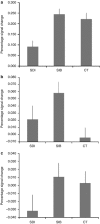Prefrontal hypoactivity associated with impaired inhibition in stimulant-dependent individuals but evidence for hyperactivation in their unaffected siblings - PubMed (original) (raw)
Prefrontal hypoactivity associated with impaired inhibition in stimulant-dependent individuals but evidence for hyperactivation in their unaffected siblings
Sharon Morein-Zamir et al. Neuropsychopharmacology. 2013 Sep.
Abstract
A neurocognitive endophenotype has been proposed for stimulant dependence, based on behavioral measures of inhibitory response control associated with white matter changes in the frontal cortex. This study investigated the functional neuroimaging correlates of inhibitory response control, as functional activity serves as a more dynamic measure than brain structure, allowing refinement of the suggested endophenotype. Stimulant-dependent individuals (SDIs), their unaffected siblings (SIBs), and healthy controls (CTs) performed the stop-signal task, including stop-signal reaction time (SSRT) as a measure of response inhibition, while undergoing functional magnetic resonance imaging. SDIs had impaired response inhibition accompanied by hypoactivation in the ventrolateral prefrontal cortex (PFC). In addition, they demonstrated hypoactivation in the anterior cingulate when failing to stop. In contrast, no hypoactivations were noted in their unaffected SIBs. Rather, they exhibited increased activation in the dorsomedial PFC relative to controls, together with inhibitory performance that was intermediate between that of the stimulant group and the healthy CT group. Such hyperactivations within the neurocircuitry underlying response inhibition and control are suggestive of compensatory mechanisms that could be protective in nature or could reflect coping with a pre-existing vulnerability, thus expressing potential aspects of resilience. The functional activation associated with response inhibition and error monitoring showed differential patterns of results between SDIs and their unaffected first-degree relatives, suggesting that the proposed endophenotype does not generalize to functional brain activity.
Figures
Figure 1
Significant brain activation maps associated with stopping in each group (P<0.05, Family-wise error). Note. Brain activation maps per group: row (a) stimulant-dependent individuals; row (b) unaffected siblings of stimulant-dependent individuals; row (c) healthy controls. Axial brain slices demonstrate main activation clusters per group at family-wise error P<0.05. The _z_-coordinate slices are: −4, 8, 24 and 48. Right side of each slice corresponds to the right side of the brain.
Figure 2
Group mean percent signal change of 8-mm spheres associated with stopping (a and b) and error monitoring (c). (a) Anterio-insula/frontal operculum, centred around coordinates: _x_=34, _y_=20, _z_=−10; (b) pre-SMA, centred around coordinates: _x_=−12, _y_=8, _z_=46; (c) anterior cingulate, centred around coordinates: _x_=16, _y_=32, _z_=18. Error bars index standard error of the mean. CT, controls; SDI, stimulant dependent individuals; SIB, unaffected siblings.
Similar articles
- Bayesian neural adjustment of inhibitory control predicts emergence of problem stimulant use.
Harlé KM, Stewart JL, Zhang S, Tapert SF, Yu AJ, Paulus MP. Harlé KM, et al. Brain. 2015 Nov;138(Pt 11):3413-26. doi: 10.1093/brain/awv246. Epub 2015 Sep 3. Brain. 2015. PMID: 26336910 Free PMC article. - Inhibitory behavioral control: A stochastic dynamic causal modeling study comparing cocaine dependent subjects and controls.
Ma L, Steinberg JL, Cunningham KA, Lane SD, Bjork JM, Neelakantan H, Price AE, Narayana PA, Kosten TR, Bechara A, Moeller FG. Ma L, et al. Neuroimage Clin. 2015 Mar 24;7:837-47. doi: 10.1016/j.nicl.2015.03.015. eCollection 2015. Neuroimage Clin. 2015. PMID: 26082893 Free PMC article. - The influence of monetary punishment on cognitive control in abstinent cocaine-users.
Hester R, Bell RP, Foxe JJ, Garavan H. Hester R, et al. Drug Alcohol Depend. 2013 Nov 1;133(1):86-93. doi: 10.1016/j.drugalcdep.2013.05.027. Epub 2013 Jun 21. Drug Alcohol Depend. 2013. PMID: 23791040 Free PMC article. - [Structural and functional neuroanatomy of attention-deficit hyperactivity disorder (ADHD)].
Emond V, Joyal C, Poissant H. Emond V, et al. Encephale. 2009 Apr;35(2):107-14. doi: 10.1016/j.encep.2008.01.005. Epub 2008 Jul 7. Encephale. 2009. PMID: 19393378 Review. French. - Systematic review of ERP and fMRI studies investigating inhibitory control and error processing in people with substance dependence and behavioural addictions.
Luijten M, Machielsen MW, Veltman DJ, Hester R, de Haan L, Franken IH. Luijten M, et al. J Psychiatry Neurosci. 2014 May;39(3):149-69. doi: 10.1503/jpn.130052. J Psychiatry Neurosci. 2014. PMID: 24359877 Free PMC article. Review.
Cited by
- A Moderated Mediation Model of Age-Related Decline in Selective Executive Functions and Quality of Life in Men with Substance Use Disorder.
Fatima S, Hassan S, Jameel F. Fatima S, et al. Clin Neuropsychiatry. 2024 Apr;21(2):143-152. doi: 10.36131/cnfioritieditore20240203. Clin Neuropsychiatry. 2024. PMID: 38807983 Free PMC article. - Fronto-striatal circuits in response-inhibition: Relevance to addiction.
Morein-Zamir S, Robbins TW. Morein-Zamir S, et al. Brain Res. 2015 Dec 2;1628(Pt A):117-29. doi: 10.1016/j.brainres.2014.09.012. Epub 2014 Sep 16. Brain Res. 2015. PMID: 25218611 Free PMC article. Review. - The importance of standardization of stimuli for functional MRI tasks to evaluate substance use disorder pathology.
Wilcox CE, Claus ED. Wilcox CE, et al. Am J Drug Alcohol Abuse. 2017 Nov;43(6):625-627. doi: 10.1080/00952990.2017.1299745. Epub 2017 Mar 27. Am J Drug Alcohol Abuse. 2017. PMID: 28345966 Free PMC article. No abstract available. - Stopping a Response When You Really Care about the Action: Considerations from a Clinical Perspective.
Morein-Zamir S, Anholt G. Morein-Zamir S, et al. Brain Sci. 2021 Jul 23;11(8):979. doi: 10.3390/brainsci11080979. Brain Sci. 2021. PMID: 34439598 Free PMC article. Review. - Fractionating impulsivity: neuropsychiatric implications.
Dalley JW, Robbins TW. Dalley JW, et al. Nat Rev Neurosci. 2017 Feb 17;18(3):158-171. doi: 10.1038/nrn.2017.8. Nat Rev Neurosci. 2017. PMID: 28209979 Review.
References
- Aichert DS, Wostmann NM, Costa A, Macare C, Wenig JR, Moller HJ, et al. Associations between trait impulsivity and prepotent response inhibition. J Clin Exp Neuropsychol. 2012;34:1016–1032. - PubMed
- American Psychiatric Association 2000Diagnostic and Statistical Manual of Mental DisordersIV-Text Revision ednAmerican Psychiatric Association: Washington, DC
- Aron AR, Fletcher PC, Bullmore ET, Sahakian BJ, Robbins TW. Stop-signal inhibition disrupted by damage to right inferior frontal gyrus in humans. Nat Neurosci. 2003;6:115–116. - PubMed
Publication types
MeSH terms
Grants and funding
- G0001354/MRC_/Medical Research Council/United Kingdom
- G1000183/MRC_/Medical Research Council/United Kingdom
- 089589/Z/09/Z/WT_/Wellcome Trust/United Kingdom
- G0701497/MRC_/Medical Research Council/United Kingdom
LinkOut - more resources
Full Text Sources
Other Literature Sources
Medical
Research Materials
Miscellaneous

